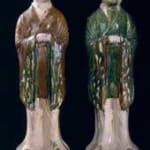Pair of T'ang Sancai-Glazed Terracotta Civic Officials, 618 CE - 906 CE
Glazed Terracotta
27.5
H.745
The T’ang Dynasty was an era of unrivalled wealth and luxury. The country was successfully reunified and the borders were expanded, pushing Chinese influence into new lands. Confucianism became a...
The T’ang Dynasty was an era of unrivalled wealth and luxury. The country was successfully reunified and the borders were expanded, pushing Chinese influence into new lands. Confucianism became a semi-religious instrument of the state; yet Buddhism continued to flourish, spreading into Korea and Japan. The arts reached new levels of sophistication. Poetry and literature flourished under the enlightened rulers. The Silk Road brought fortunes into China. Precious treasures were imported on the backs of camels from far away lands and bartered for Chinese silk, medicinal herbs, and pungent spices. T’ang China was a multicultural empire where foreign merchants from across Central Asia and the Middle East settled in the urban centers, foremost among them the thriving capital of Chang’an (modern X’ian), a bustling cosmopolitan center of over two million inhabitants. Foreign traders lived next to native artisans and both thrived. New ideas and exotic artistic forms followed alongside. The T’ang Dynasty was a cultural renaissance where many of the forms and objects we now associate with China were first created. Moreover, this period represents one of the greatest cultural outpourings in human history.
I spend the morning going through Government papers,
I spend the evening going through Government papers.
--Bai Juyi, poet and official, writing while governor of Suzhou, 825 A
This general type of Chinese burial art is known as . were any of a variety of objects specifically created for interment in the tombs of elite individuals in order to provide for the afterlife. This statue represents a civic official from the vast governmental bureaucracy of the T’ang Empire. With over two million inhabitants in greater Chang’an, the cosmopolitan capital of the T’ang, the governance of just this city alone would have demanded an extensive network of civic servants, not to mention the numerous distant provinces of that comprised the greater Empire. In order to remove power from the hands of wealthy aristocrats and warlords, the T’ang created a class of scholar officials to govern their lands, enacting the will of the Imperial Court throughout China. Rigorous examinations ensured that only the most qualified individuals were able to serve this crucial position.
These civic officials represented the role of the government in the life of the citizens, as significant to their well being as military might. The facial features of these figures, including their aquiline noses and serene expressions, reveal their intellectual wisdom and calm restraint. The gorgeous Sancai glaze covers their robes, and even parts of their faces. Buried underground, these officials were interred in order to welcome the deceased into the afterlife and to ensure his comfort in the great beyond.
I spend the morning going through Government papers,
I spend the evening going through Government papers.
--Bai Juyi, poet and official, writing while governor of Suzhou, 825 A
This general type of Chinese burial art is known as . were any of a variety of objects specifically created for interment in the tombs of elite individuals in order to provide for the afterlife. This statue represents a civic official from the vast governmental bureaucracy of the T’ang Empire. With over two million inhabitants in greater Chang’an, the cosmopolitan capital of the T’ang, the governance of just this city alone would have demanded an extensive network of civic servants, not to mention the numerous distant provinces of that comprised the greater Empire. In order to remove power from the hands of wealthy aristocrats and warlords, the T’ang created a class of scholar officials to govern their lands, enacting the will of the Imperial Court throughout China. Rigorous examinations ensured that only the most qualified individuals were able to serve this crucial position.
These civic officials represented the role of the government in the life of the citizens, as significant to their well being as military might. The facial features of these figures, including their aquiline noses and serene expressions, reveal their intellectual wisdom and calm restraint. The gorgeous Sancai glaze covers their robes, and even parts of their faces. Buried underground, these officials were interred in order to welcome the deceased into the afterlife and to ensure his comfort in the great beyond.



